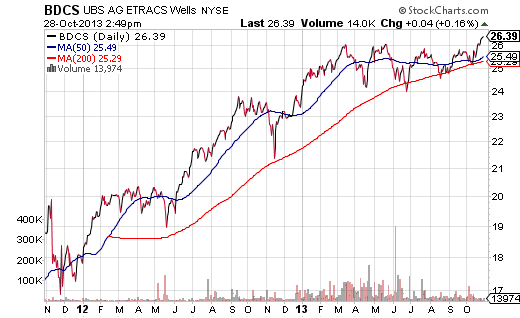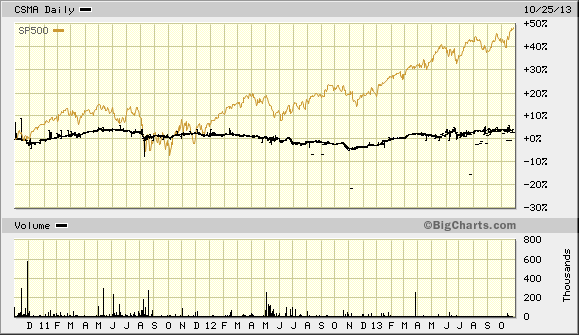Is anyone bothered by the bizarre relationship between a sub-par economy and ever-rising stock prices? In brief, dismal hiring coupled with negligible wage growth encourage the Federal Reserve to continue suppressing interest rates with its emergency bond buying program. Corporations use the ultra-low rates to refinance debt, repurchase stock shares, cut costs and enhance profit margins, while rarely using the easy money to hire. Meanwhile, investors increase their margin exposure to buy riskier assets and/or simply opt for riskier assets over the non-yielding bond market. In fact, companies may not be selling products or services particularly well, but their balance sheets look spectacular.
Indeed, the relationship between asset prices and economic well-being has turned into an incongruous circle of silliness. The Fed’s rate manipulation goals were supposed to get businesses to hire and consumers to spend. Neither is occurring at the level that the central bank had anticipated. Unfortunately, the cessation of bond acquisition activity at this point would likely hinder price appreciation in housing as well as stocks. In turn, this leaves Bernanke/Yellen with an unenviable choice. The Fed can accept a probable recession by winding down quantitative easing (QE) or keep hoping that the ever-increasing net worth of companies as well as wealthy individuals will someday translate into new jobs and vibrant consumption.
If the discussion is a bit too much to swallow, then let me simplify. “Buy, buy, buy.” As long as the Fed continues acquiring low-yielding bonds with money that it does not actually have, savers and investors will find themselves needing to do things with their capital that they normally would not do. Take more risk.
When a caller recently asked financial personality Ric Edelman what to do about the inability to live off the interest of CDs and savings, he explained that the only viable alternative was to diversify a portfolio across 18-19 asset classes. “If you don’t want to erode your principal, you have no other choice,” he insisted. For the most part, he has a valid point. The risk of outliving one’s money may be greater for many folks than the risk of participating in a diversified mix of stocks, bonds, REITs, partnerships, currencies, commodities and alternative assets.
In this commentary, I am choosing to look at some alternative asset exchange-traded funds. They are often misunderstood, rarely discussed in detail and they may go the furthest toward reducing overall portfolio risk. If the “fit hits the shan” the way it did in the financial collapse of 2008, then most asset classes (e.g., most stock types, most bond types, most REITs, most currencies, most commodities, etc.) could depreciate significantly. Alternative assets may or may not do much better, but when it comes to a world where the Fed is likely to remain exceptionally accommodative, “alt assets” are worthy of discussion.
Here are 3 exchange-traded investments for tapping into a world of alternative possibilities:
1. ETRACS Wells Fargo Business Development Company Index Note (BDCS). Business Development Companies (BDCs) are similar to venture capitalists and private equity firms. In particular, there are roughly 30 or more publicly traded corporations that engage in lending at high yield rates to smaller up-n-comers; BDCs often garner equity stakes as well. The Securities and Exchange Commission (SEC) requires these BDCs to invest 70% of assets in U.S. companies, while distributing a minimum of 90% of taxable income in the form of dividends. Those distributions often lead to annual yields in the 7%-9% range for shareholders.
Not surprisingly, there are exchange-traded vehicles for BDCs. The unleveraged ETN from UBS E-TRACS, ticker symbol BDCS, is a means for accessing the alternative asset class. Capital appreciation may be a little light in 2013, though the 7% annualized yield is a nice offset; rising interest rates in the May-June period did not hurt BDCS more than the market at large. Moreover, the 50-day moving average has remained above the 200-day moving average since early in 2012.
2. ProShares Large Cap Core Plus (CSM). Before fees and expenses, CSM pursues the results of Credit Suisse’s 130/30 Large Cap Index. The 130/30 paradigm has become increasingly popular in the alternative arena, where an index has total long exposure of 130% and total short exposure of 30%. In this vehicle, the 500 largest stocks comprise the universe where a rules-based ranking system determines which companies will make up the “long” and which will make up the “short.”
However, there is very little discernible performance difference or price direction when compared to the S&P 500 SPDR Trust (SPY). Both have three-year total returns of roughly 58%; both move in the same direction 99 times out of 100. The advocates of 130/30 strategies swear by the approach’s ability to deliver excess returns for less risk, but the evidence is pretty slim… at least in the passive world of ETF indexing.
3. Credit Suisse Merger Arbitrage Index ETN (CSMA). In merger arbitrage, one is pursuing the spread between the stock price of a target company after the public announcement of its proposed acquisition and the price offered by the acquirer to pay for the targeted company’s shares. If a deal goes through as anticipated, gains are probable. If a deal fails to materialize, losses may occur.
Compared to the previous “alt” assets, CSMA provides the least annualized volatility and the lowest correlation with the S&P 500 with a coefficient of 0.39. In the same vein, however, the investment may not provide much of anything of value. Over the previous three years, the profits are frighteningly slim. 
For the most part, alternative ETFs may not be alternative enough. And when they are, they may not provide enough value to warrant their inclusion. That means the majority of ETF enthusiasts should stick with mainstream offerings tied to stocks, bonds, REITs and commodities. Moreover, since few of the primary asset classes will hold up in a systemic shock, you’ll need to actively manage the downside risk with an approach to lowering your overall exposure.
Disclosure: Gary Gordon, MS, CFP is the president of Pacific Park Financial, Inc., a Registered Investment Adviser with the SEC. Gary Gordon, Pacific Park Financial, Inc, and/or its clients may hold positions in the ETFs, mutual funds, and/or any investment asset mentioned above. The commentary does not constitute individualized investment advice. The opinions offered herein are not personalized recommendations to buy, sell or hold securities. At times, issuers of exchange-traded products compensate Pacific Park Financial, Inc. or its subsidiaries for advertising at the ETF Expert web site. ETF Expert content is created independently of any advertising relationships.
- English (UK)
- English (India)
- English (Canada)
- English (Australia)
- English (South Africa)
- English (Philippines)
- English (Nigeria)
- Deutsch
- Español (España)
- Español (México)
- Français
- Italiano
- Nederlands
- Português (Portugal)
- Polski
- Português (Brasil)
- Русский
- Türkçe
- العربية
- Ελληνικά
- Svenska
- Suomi
- עברית
- 日本語
- 한국어
- 简体中文
- 繁體中文
- Bahasa Indonesia
- Bahasa Melayu
- ไทย
- Tiếng Việt
- हिंदी
Alternative ETFs: Can You Increase Your Risk-Adjusted Performance?
Published 10/29/2013, 02:08 AM
Updated 03/09/2019, 08:30 AM
Alternative ETFs: Can You Increase Your Risk-Adjusted Performance?
Latest comments
Loading next article…
Install Our App
Risk Disclosure: Trading in financial instruments and/or cryptocurrencies involves high risks including the risk of losing some, or all, of your investment amount, and may not be suitable for all investors. Prices of cryptocurrencies are extremely volatile and may be affected by external factors such as financial, regulatory or political events. Trading on margin increases the financial risks.
Before deciding to trade in financial instrument or cryptocurrencies you should be fully informed of the risks and costs associated with trading the financial markets, carefully consider your investment objectives, level of experience, and risk appetite, and seek professional advice where needed.
Fusion Media would like to remind you that the data contained in this website is not necessarily real-time nor accurate. The data and prices on the website are not necessarily provided by any market or exchange, but may be provided by market makers, and so prices may not be accurate and may differ from the actual price at any given market, meaning prices are indicative and not appropriate for trading purposes. Fusion Media and any provider of the data contained in this website will not accept liability for any loss or damage as a result of your trading, or your reliance on the information contained within this website.
It is prohibited to use, store, reproduce, display, modify, transmit or distribute the data contained in this website without the explicit prior written permission of Fusion Media and/or the data provider. All intellectual property rights are reserved by the providers and/or the exchange providing the data contained in this website.
Fusion Media may be compensated by the advertisers that appear on the website, based on your interaction with the advertisements or advertisers.
Before deciding to trade in financial instrument or cryptocurrencies you should be fully informed of the risks and costs associated with trading the financial markets, carefully consider your investment objectives, level of experience, and risk appetite, and seek professional advice where needed.
Fusion Media would like to remind you that the data contained in this website is not necessarily real-time nor accurate. The data and prices on the website are not necessarily provided by any market or exchange, but may be provided by market makers, and so prices may not be accurate and may differ from the actual price at any given market, meaning prices are indicative and not appropriate for trading purposes. Fusion Media and any provider of the data contained in this website will not accept liability for any loss or damage as a result of your trading, or your reliance on the information contained within this website.
It is prohibited to use, store, reproduce, display, modify, transmit or distribute the data contained in this website without the explicit prior written permission of Fusion Media and/or the data provider. All intellectual property rights are reserved by the providers and/or the exchange providing the data contained in this website.
Fusion Media may be compensated by the advertisers that appear on the website, based on your interaction with the advertisements or advertisers.
© 2007-2024 - Fusion Media Limited. All Rights Reserved.
